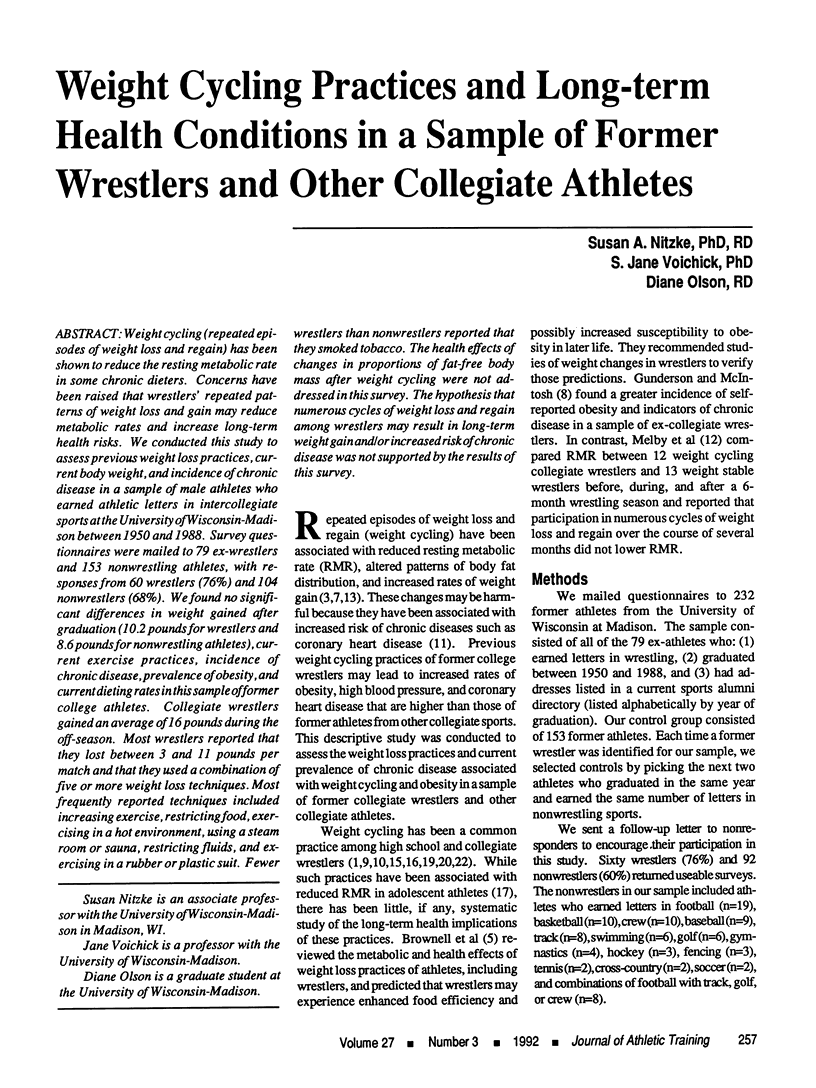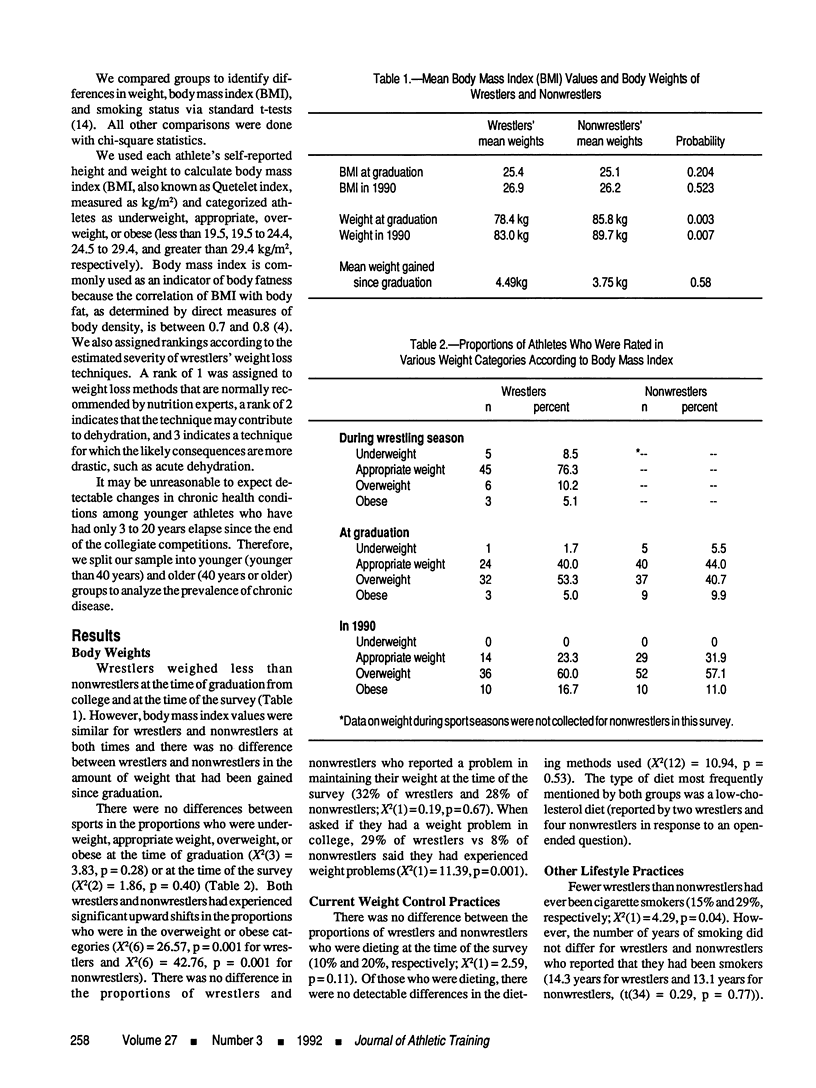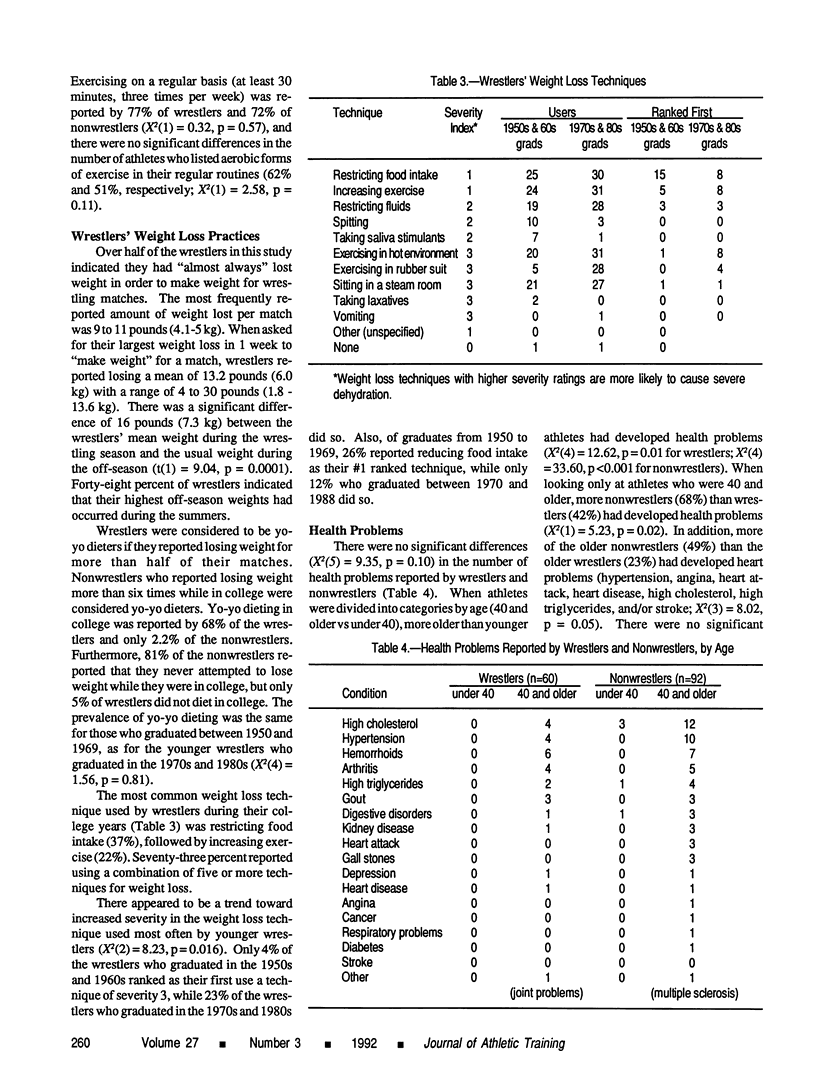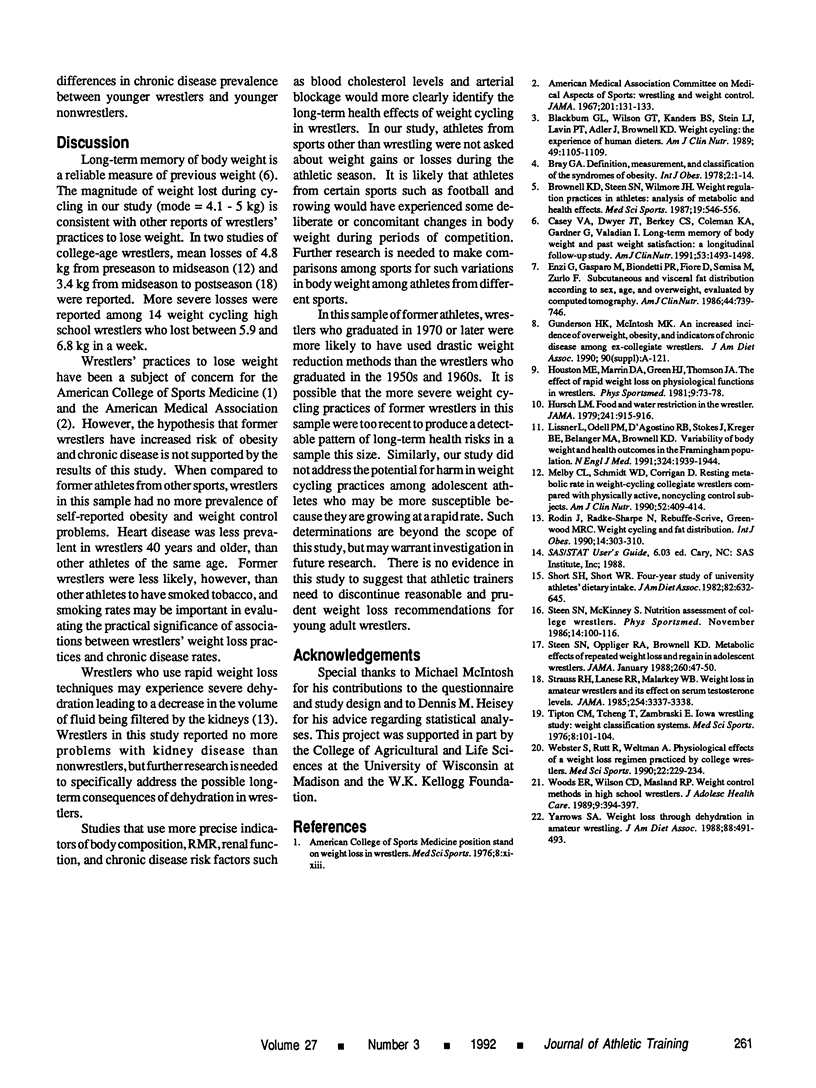Abstract
Weight cycling (repeated episodes of weight loss and regain) has been shown to reduce the resting metabolic rate in some chronic dieters. Concerns have been raised that wrestlers' repeated patterns of weight loss and gain may reduce metabolic rates and increase long-term health risks. We conducted this study to assess previous weight loss practices, current body weight, and incidence of chronic disease in a sample of male athletes who earned athletic letters in intercollegiate sports at the University of Wisconsin-Madison between 1950 and 1988. Survey questionnaires were mailed to 79 ex-wrestlers and 153 nonwrestling athletes, with responses from 60 wrestlers (76%) and 104 nonwrestlers (68%). We found no significant differences in weight gained after graduation (10.2 pounds for wrestlers and 8.6 pounds for nonwrestling athletes), current exercise practices, incidence of chronic disease, prevalence of obesity, and current dieting rates in this sample of former college athletes. Collegiate wrestlers gained an average of 16 pounds during the off-season. Most wrestlers reported that they lost between 3 and 11 pounds per match and that they used a combination of five or more weight loss techniques. Most frequently reported techniques included increasing exercise, restricting food, exercising in a hot environment, using a steam room or sauna, restricting fluids, and exercising in a rubber or plastic suit. Fewer wrestlers than nonwrestlers reported that they smoked tobacco. The health effects of changes in proportions of fat-free body mass after weight cycling were not addressed in this survey. The hypothesis that numerous cycles of weight loss and regain among wrestlers may result in long-term weight gain and/or increased risk of chronic disease was not supported by the results of this survey.
Full text
PDF



Selected References
These references are in PubMed. This may not be the complete list of references from this article.
- Blackburn G. L., Wilson G. T., Kanders B. S., Stein L. J., Lavin P. T., Adler J., Brownell K. D. Weight cycling: the experience of human dieters. Am J Clin Nutr. 1989 May;49(5 Suppl):1105–1109. doi: 10.1093/ajcn/49.5.1105. [DOI] [PubMed] [Google Scholar]
- Brownell K. D., Steen S. N., Wilmore J. H. Weight regulation practices in athletes: analysis of metabolic and health effects. Med Sci Sports Exerc. 1987 Dec;19(6):546–556. [PubMed] [Google Scholar]
- Casey V. A., Dwyer J. T., Berkey C. S., Coleman K. A., Gardner J., Valadian I. Long-term memory of body weight and past weight satisfaction: a longitudinal follow-up study. Am J Clin Nutr. 1991 Jun;53(6):1493–1498. doi: 10.1093/ajcn/53.6.1493. [DOI] [PubMed] [Google Scholar]
- Enzi G., Gasparo M., Biondetti P. R., Fiore D., Semisa M., Zurlo F. Subcutaneous and visceral fat distribution according to sex, age, and overweight, evaluated by computed tomography. Am J Clin Nutr. 1986 Dec;44(6):739–746. doi: 10.1093/ajcn/44.6.739. [DOI] [PubMed] [Google Scholar]
- Garratty G., Houston M., Petz L. D., Webb M. Acute immune intravascular hemolysis due to hydrochlorothiazide. Am J Clin Pathol. 1981 Jul;76(1):73–78. doi: 10.1093/ajcp/76.1.73. [DOI] [PubMed] [Google Scholar]
- Hursh L. M. Food and water restriction in the wrestler. JAMA. 1979 Mar 2;241(9):915–916. [PubMed] [Google Scholar]
- Melby C. L., Schmidt W. D., Corrigan D. Resting metabolic rate in weight-cycling collegiate wrestlers compared with physically active, noncycling control subjects. Am J Clin Nutr. 1990 Sep;52(3):409–414. doi: 10.1093/ajcn/52.3.409. [DOI] [PubMed] [Google Scholar]
- Rodin J., Radke-Sharpe N., Rebuffé-Scrive M., Greenwood M. R. Weight cycling and fat distribution. Int J Obes. 1990 Apr;14(4):303–310. [PubMed] [Google Scholar]
- Short S. H., Short W. R. Four-year study of university athletes' dietary intake. J Am Diet Assoc. 1983 Jun;82(6):632–645. [PubMed] [Google Scholar]
- Steen S. N., Oppliger R. A., Brownell K. D. Metabolic effects of repeated weight loss and regain in adolescent wrestlers. JAMA. 1988 Jul 1;260(1):47–50. [PubMed] [Google Scholar]
- Strauss R. H., Lanese R. R., Malarkey W. B. Weight loss in amateur wrestlers and its effect on serum testosterone levels. JAMA. 1985 Dec 20;254(23):3337–3338. [PubMed] [Google Scholar]
- Tipton C. M., Tcheng T. K., Zambraski E. J. Iowa wrestling study: weight classification systems. Med Sci Sports. 1976 Summer;8(2):101–104. [PubMed] [Google Scholar]
- Webster S., Rutt R., Weltman A. Physiological effects of a weight loss regimen practiced by college wrestlers. Med Sci Sports Exerc. 1990 Apr;22(2):229–234. [PubMed] [Google Scholar]
- Woods E. R., Wilson C. D., Masland R. P., Jr Weight control methods in high school wrestlers. J Adolesc Health Care. 1988 Sep;9(5):394–397. doi: 10.1016/0197-0070(88)90035-6. [DOI] [PubMed] [Google Scholar]
- Yarrows S. A. Weight loss through dehydration in amateur wrestling. J Am Diet Assoc. 1988 Apr;88(4):491–493. [PubMed] [Google Scholar]


